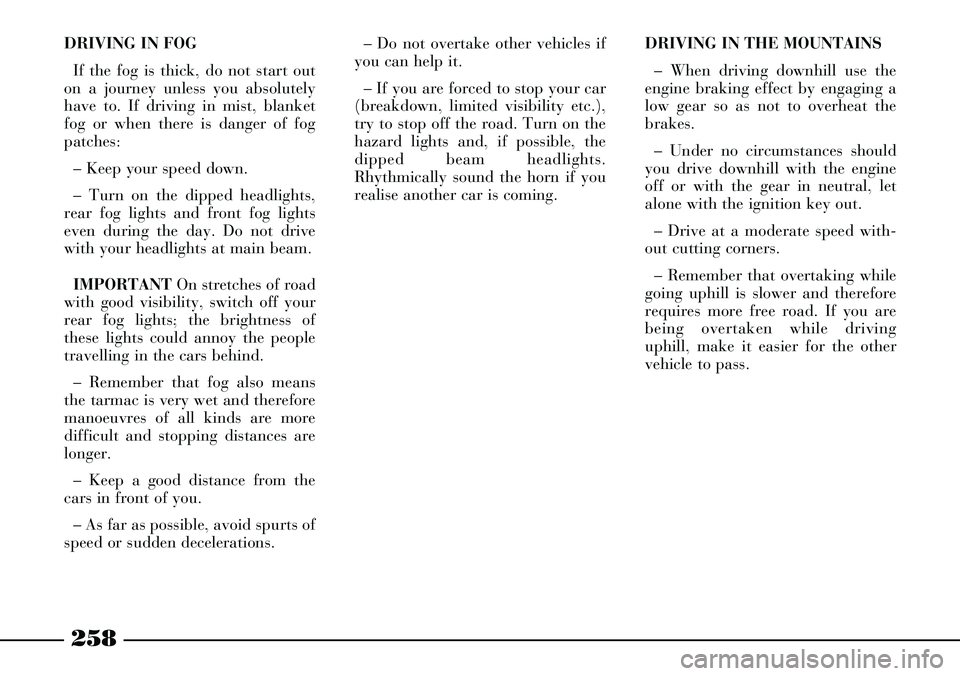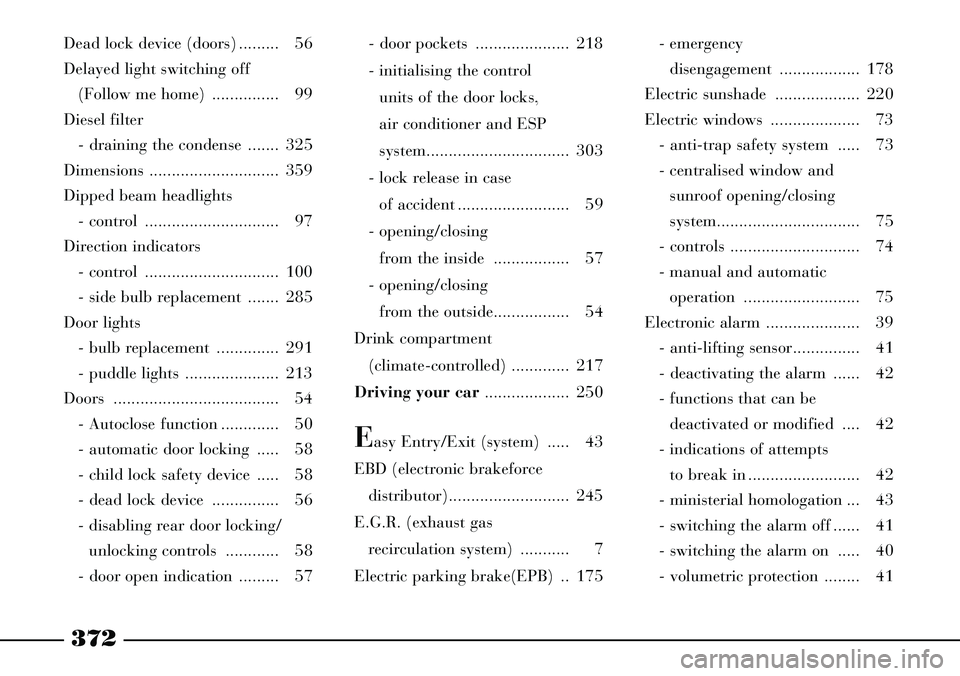low beam Lancia Thesis 2006 Owner handbook (in English)
[x] Cancel search | Manufacturer: LANCIA, Model Year: 2006, Model line: Thesis, Model: Lancia Thesis 2006Pages: 386, PDF Size: 8.69 MB
Page 259 of 386

258
DRIVING IN FOG
If the fog is thick, do not start out
on a journey unless you absolutely
have to. If driving in mist, blanket
fog or when there is danger of fog
patches:
– Keep your speed down.
– Turn on the dipped headlights,
rear fog lights and front fog lights
even during the day. Do not drive
with your headlights at main beam.
IMPORTANTOn stretches of road
with good visibility, switch off your
rear fog lights; the brightness of
these lights could annoy the people
travelling in the cars behind.
– Remember that fog also means
the tarmac is very wet and therefore
manoeuvres of all kinds are more
difficult and stopping distances are
longer.
– Keep a good distance from the
cars in front of you.
– As far as possible, avoid spurts of
speed or sudden decelerations. – Do not overtake other vehicles if
you can help it.
– If you are forced to stop your car
(breakdown, limited visibility etc.),
try to stop off the road. Turn on the
hazard lights and, if possible, the
dipped beam headlights.
Rhythmically sound the horn if you
realise another car is coming. DRIVING IN THE MOUNTAINS
– When driving downhill use the
engine braking effect by engaging a
low gear so as not to overheat the
brakes.
– Under no circumstances should
you drive downhill with the engine
off or with the gear in neutral, let
alone with the ignition key out.
– Drive at a moderate speed with-
out cutting corners.
– Remember that overtaking while
going uphill is slower and therefore
requires more free road. If you are
being overtaken while driving
uphill, make it easier for the other
vehicle to pass.
Page 283 of 386

282
GENERAL INSTRUCTIONS
– When a light is not working,
check that it has not fused before
changing the bulb.
– For the location of the fuses, refer
to “If a fuse blows” in this chapter.
– Before replacing a bulb that does
not work, check that the contacts are
not oxidised.
– Burnt-out bulbs must be replaced
with ones of the same type and
power.
– Always check the slant of the
headlight beam after changing a
bulb for safety reasons.TYPES OF BULBS
Different types of bulbs are
installed in the car (fig. 22):
A - All glass bulbs
Snapped into position. Pull to
remove.
B - Bayonet connection bulbs
Remove from the bulb holder by
pressing the bulb and rotating it
anticlockwise.
C - Cylindrical bulbs
Remove by pulling away from ter-
minals.
D - E Halogen bulbs
To remove the bulb, release the
clip holding the bulb in place.
L0A0105b
fig. 22
Page 285 of 386

284
IF AN EXTERIOR
BULB BURNS OUT
FRONT LIGHT CLUSTER
The front light cluster includes
main beam headlights/dipped beam
headlights, additional main beam
headlights, direction indicators and
sidelights.Light layout is the following
(fig. 23):
A– Main beam headlight/dipped
beam headlight (bi-Xeno bulb)
B– Sidelight
C– Additional main beam head-
light
D– Direction indicator.Any operation on the
front light cluster must be
made with the stalk at 0
(lights off) and ignition key
removed for at least 15 minutes
(to let bulb cooling and con-
densers discharging): risk of elec-
trical discharge!
fig. 23
L0A0106b
To replace front head-
light bulbs, front light
clusters shall be removed.
It is therefore recommended to
the bulbs replaced at Lancia
Dealership.Due to high voltage, the
bulb of bi-Xeno gas-dis-
charge headlights must
only be replaced by experts: dan-
ger of death! Contact the Lancia
Dealership.
Page 373 of 386

372
Dead lock device (doors) ......... 56
Delayed light switching off
(Follow me home) ............... 99
Diesel filter
- draining the condense ....... 325
Dimensions ............................. 359
Dipped beam headlights
- control .............................. 97
Direction indicators
- control .............................. 100
- side bulb replacement ....... 285
Door lights
- bulb replacement .............. 291
- puddle lights ..................... 213
Doors ..................................... 54
- Autoclose function ............. 50
- automatic door locking ..... 58
- child lock safety device ..... 58
- dead lock device ............... 56
- disabling rear door locking/
unlocking controls ............ 58
- door open indication ......... 57- door pockets ..................... 218
- initialising the control
units of the door locks,
air conditioner and ESP
system................................ 303
- lock release in case
of accident ......................... 59
- opening/closing
from the inside ................. 57
- opening/closing
from the outside................. 54
Drink compartment
(climate-controlled) ............. 217
Driving your car................... 250
Easy Entry/Exit (system) ..... 43
EBD (electronic brakeforce
distributor)........................... 245
E.G.R. (exhaust gas
recirculation system) ........... 7
Electric parking brake(EPB) .. 175- emergency
disengagement .................. 178
Electric sunshade ................... 220
Electric windows .................... 73
- anti-trap safety system ..... 73
- centralised window and
sunroof opening/closing
system................................ 75
- controls ............................. 74
- manual and automatic
operation .......................... 75
Electronic alarm ..................... 39
- anti-lifting sensor............... 41
- deactivating the alarm ...... 42
- functions that can be
deactivated or modified .... 42
- indications of attempts
to break in ......................... 42
- ministerial homologation ... 43
- switching the alarm off ...... 41
- switching the alarm on ..... 40
- volumetric protection ........ 41
Page 374 of 386

373
- what triggers the alarm
off ..................................... 42
Electronic automatic gearbox
(COMFORTRONIC) ............. 180
- automatic operation ........... 182
- bump starting .................... 188
- failure indication ............... 187
- gearbox display.................. 110
- manual sequential
operation ........................... 186
- moving off ......................... 180
- selecting the automatic/
manual sequential
operation ........................... 182
- sound signal ..................... 188
- starting the engine ............ 180
- stopping ............................. 181
- technical specifications ..... 348
- towing the car ................... 189
Electronic brakeforce
distributor (EBD) .................... 245
Electronic control units
(important) ......................... 330Engine
- identification code ............ 341
- marking ............................ 341
- technical specifications ..... 344
Engine compartment
(cleaning) ............................ 339
Engine coolant ........................ 321
Engine coolant temperature
gauge .................................. 108
Engine oil
- checking level ................... 320
- specifications ..................... 364
Engine oil consumption .......... 321
Engine oil level ....................... 320
Engine warming up ................ 252
Environment
(safety and protection) ......... 4-5
EOBD system ......................... 244
EPB (electric parking brake) .. 175
- emergency disengagement.. 178
ESP system ............................ 189
- ASR function .................... 191- ESP system action ............. 192
- failure indication .............. 192
- initialising the control units
of the door locks, air
conditioner and ESP
system................................ 303
- MSR system ....................... 192
- operation .......................... 190
Exhaust gas
(recirculation system) .......... 7
External lights (controls) ........ 97
Flash consumption
gauge .................................. 109
Flashing the headlights
(main beam) ....................... 100
Fluids and lubricants .............. 364
Follow me home
(delayed light switching off) 99
Front ceiling light ................... 212
- bulb replacement .............. 287